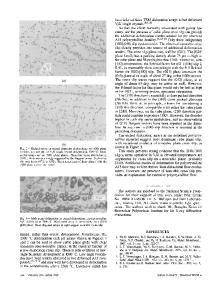Twinning in A-15 Compounds
- PDF / 388,100 Bytes
- 6 Pages / 420.48 x 639 pts Page_size
- 83 Downloads / 4,361 Views
TWINNING IN A-15 COMPOUNDS M.KHANTHA, V.VITEK AND D.P.POPE Department of Materials Science and Engineering, Philadelphia, PA 19104-6272.
University
of Pennsylvania,
ABSTRACT Twinning modes in topologically close-packed A-15 compounds are examined from a geometrical viewpoint. The crystallographically possible twinning modes with a shear less than a certain maximum are tabulated along with the percentage of shuffles involved for each of the modes. Based on some simple criteria, two of the most likely modes for deformation twinning are discussed in detail. The shuffle parameters usually employed to determine the percentage of lattice shuffles for a given mode have not been found to be useful in these structures because the primitive unit cell typically contains more than one formula unit. One has to examine the distribution of atoms in detail in order to determine the percentage of shuffles involved. INTRODUCYION A vast number of binary and ternary alloys belong to the family of structures called 'topologically close-packed' (tcp) [1]. Many alloys of these structures have attractive properties such as high melting temperatures, low specific gravity, high stiffness-to-weight ratio, etc. [2]. However, like many other intermetallics, they are usually inherently brittle at ambient temperatures. In order to investigate possible ways of improving their ductility, it is first necessary to study possible modes of deformation in these compounds. Plastic deformation associated with glide of dislocations is often limited, but, a feasible alternative mode of deformation may be twinning. This has motivated us to carry out a crystallographic analysis of all possible twinning modes in some tcp structures with shear less than a certain maximum. We discuss certain general aspects of twinning in these phases and present more detailed results for the A-15 compounds. The characteristic feature of tcp phases is that only tetrahedral interstices are present in their structures [3]. Since the region around a tetrahedral interstice represents a denser arrangement of spherical atoms than around an octahedral one, the presence of exclusively tetrahedral interstices in the tcp structures gives rise to a high uniform packing density of atoms. The tetrahedral voids are, however, geometrically imperfect due to the different sizes of the atoms forming the binary or ternary alloys. All the tcp structures are made up of interpenetrating Kasper polyhedra [4] with coordination numbers 12, 14, 15, and 16. This condition, combined with the stacking rule that only tetrahedral voids be present, leads to all tcp phases being layered compounds. The present study pertains to the simplest of the tcp compounds, namely, the A-15 binary alloys. Some examples of alloys crystallizing in
Mat. Res. Soc. Symp. Proc. Vol. 133. t 1989 Materials Research Society
100
this structure are V3Si, V3A1, Cr 3Si, Ti3Ir, etc. The A-15, or the 03-tungsten phase, occurs generally at the stoichiometry A 3B though there are some exceptions. It belongs to the space group Oh 3-P
Data Loading...











